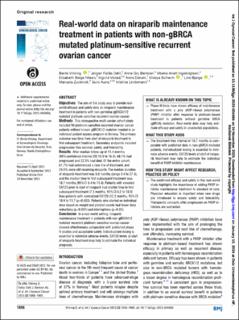| dc.contributor.author | Elgaaen, Bente Vilming | |
| dc.contributor.author | Dahl, Jørgen Fallås | |
| dc.contributor.author | Bentzen, Anne Gry | |
| dc.contributor.author | Ingebrigtsen, Vibeke Anett | |
| dc.contributor.author | Nilsen, Elisabeth Berge | |
| dc.contributor.author | Vistad, Ingvild | |
| dc.contributor.author | Dørum, Anne | |
| dc.contributor.author | Popova, Olesya | |
| dc.contributor.author | Bjørge, Line | |
| dc.contributor.author | Zucknick, Manuela | |
| dc.contributor.author | Aune, Guro | |
| dc.contributor.author | Lindemann, Kristina Yvonne Kathe | |
| dc.date.accessioned | 2024-04-17T10:39:04Z | |
| dc.date.available | 2024-04-17T10:39:04Z | |
| dc.date.created | 2023-12-18T11:08:15Z | |
| dc.date.issued | 2023 | |
| dc.identifier.issn | 1048-891X | |
| dc.identifier.uri | https://hdl.handle.net/11250/3126981 | |
| dc.description.abstract | Objectives The aim of this study was to provide real-world efficacy and safety data on niraparib maintenance treatment in patients with non-germline (gBRCA)1/2 mutated platinum-sensitive recurrent ovarian cancer.
Methods This retrospective multi-center cohort study included 94 platinum-sensitive recurrent ovarian cancer patients without known gBRCA1/2 mutation treated in an individual patient access program in Norway. The primary outcome was time from start of niraparib treatment to first subsequent treatment. Secondary endpoints included progression-free survival, safety, and tolerability.
Results After median follow-up of 13.4 months (95% confidence interval (CI) 10.0 to 16.8), 68.1% had progressed and 22.3% had died. Of the entire cohort, 61.7% had commenced a new line of treatment, and 24.5% were still receiving niraparib. The median duration of niraparib treatment was 5.0 months (range 0.4 to 27.3), and the median time to first subsequent treatment was 10.7 months (95% CI 8.4 to 13.0). Patients with elevated CA125 prior to start of niraparib had shorter time to first subsequent treatment (7.3 months, 95% CI 4.2 to 10.3) than patients with normalized CA125 (12.2 months, 95% CI 10.9 to 13.7 (p=0.002). Patients who started on individual dose based on weight and platelet counts had fewer dose reductions (p<0.001) and interruptions (p=0.02).
Conclusion In a real-world setting, niraparib maintenance treatment in patients with non-gBRCA1/2 mutated recurrent platinum-sensitive ovarian cancer showed effectiveness comparable with published phase III studies and acceptable safety. Individualized dosing is essential to minimize adverse events. CA125 levels at start of niraparib treatment may help to estimate the individual prognosis. | en_US |
| dc.language.iso | eng | en_US |
| dc.publisher | BMJ | en_US |
| dc.rights | Navngivelse-Ikkekommersiell 4.0 Internasjonal | * |
| dc.rights.uri | http://creativecommons.org/licenses/by-nc/4.0/deed.no | * |
| dc.title | Real-world data on niraparib maintenance treatment in patients with non-gBRCA mutated platinum-sensitive recurrent ovarian cancer | en_US |
| dc.type | Journal article | en_US |
| dc.type | Peer reviewed | en_US |
| dc.description.version | publishedVersion | en_US |
| dc.rights.holder | Copyright 2023 IGCS and ESGO | en_US |
| cristin.ispublished | true | |
| cristin.fulltext | original | |
| cristin.qualitycode | 1 | |
| dc.identifier.doi | 10.1136/ijgc-2023-004484 | |
| dc.identifier.cristin | 2214746 | |
| dc.source.journal | International Journal of Gynecological Cancer | en_US |
| dc.source.pagenumber | 1898–1905 | en_US |
| dc.identifier.citation | International Journal of Gynecological Cancer. 2023, 33, 1898–1905. | en_US |
| dc.source.volume | 33 | en_US |

